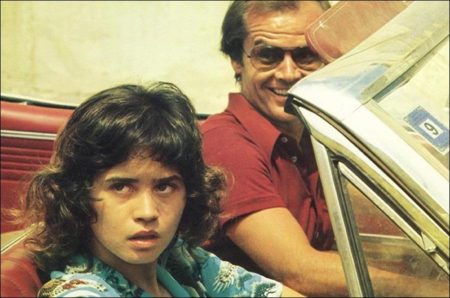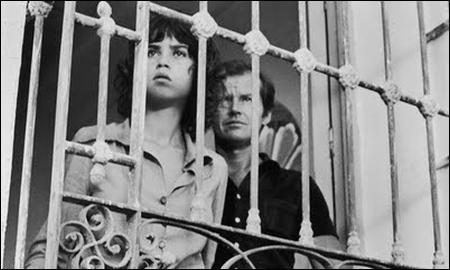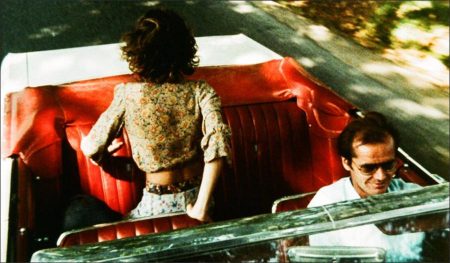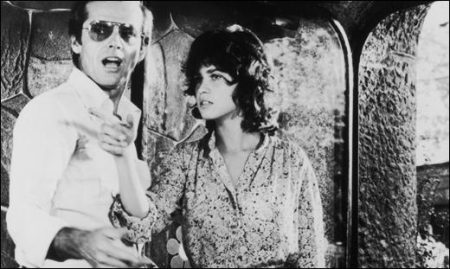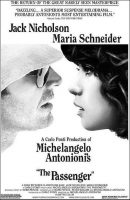Taglines: I used to be somebody else…but I traded him in.
One of Jack Nicholson’s best but also least known films, `The Passenger’ or `Professione: Reporter). A melancholy, depressed and jaded television reporter assumes the identity of a dead man while at a hotel in a north African country, not knowing that the man was a renowned arms smuggler. The newsman sees this switch as a last desperate chance to escape his old life and start anew. However, as he begins to take on the characteristics of his new persona and understand his shady involvements, the decision becomes a risky one, which leads to an inevitable showdown.
David Locke is a television reporter on location in Africa. It’s hot, humid, and everything seems to be dirty. Returning to his hotel after getting lost and bogged in the desert, he discovers that the man in the room next to his is dead.
After deciding that his own life wasn’t worth living anymore, he switches identities with the dead man, taking the man’s passport (with his own photo swapped in), his luggage, and his appointment schedule. Leaving Africa, he heads off to keep the dead man’s appointments, hoping that his new life will be more interesting than his old one was.
Originally released in 1975, The Passenger is, on the simplest level, a suspense story about a man trying to escape his own life. This haunting film is a portrait of a drained journalist, played by Jack Nicholson, whose deliverance is an identity exchange with a dead man. The film was shot on location and takes Nicholson on an incredible journey through Africa, Spain, Germany and England.
As with all of Antonioni’s work, however, there is another dimension. From beginning to end we are witnessing a probing study of the human condition. The protagonist’s fate reflects each individual’s own private thoughts about real and/or imagined destiny. The climax of the film, alone – a final sequence lasting seven minutes and taking eleven days to shoot is truly a synthesis of the movie and a tribute to the director’s art.
Antonioni, in talking about his motion picture, says: “I consider The Passenger my most stylistically mature film. I also consider it a political film as it is topical and fits with the dramatic rapport of the individual in today’s society.”
The Passengerbrought together two of the screen’s most exciting personalities, Jack Nicholson and Maria Schneider, who had become an overnight sensation opposite Marlon Brando in “Last Tango in Paris.” The Passenger is based on an original story by Mark Peploe and was filmed from a screenplay by Peploe, Peter Wollen and Antonioni.
This preferred director’s cut is the version of the film that was originally released in Europe under the title Professione: Reporter.
About the Film
“The Passenger” was filmed on location in Spain, England, Germany and Algeria. In Spain, much use was made of Barcelona, the country’s commercial center. Scenes were shot in the Ramblas, one of the oldest and most picturesque streets in Europe. The Palaccio Guell, built by the great Spanish architect Gaudi, was used by Antonioni for an encounter between Nicholson and Schneider. Built originally for a clothing manufacturer, the Palaccio is now a museum of theatrical arts and is a surrealistic construction that defies the imagination.
From Barcelona the film traveled for scenes in the streets and orange groves of Almeria, before moving to Malaga, Spain’s most chic tourist resort. Further sequences were shot in Seville, an ancient city in the heart of Andalusia, and the unit then crossed the Mediterranean to Algeria for two weeks at Fort Polignanc in the heart of the desert which doubled for the African state of Chad. During this period cast and crew lived under canvas. After the heat and primitive qualities of Spain and Algeria, the company spent five weeks in London, filming in elegant Georgian Square, a television studio and modern housing complex in Bloomsbury.
About Michelangelo Antonioni
Italian filmmaker Michelangelo Antonioni is one of the most individualistic and innovative film directors of our time. Throughout his years of writing and directing he has redefined the concept of narrative cinema. Driven by his instability, his films reflected and challenged the accepted notions at the heart of storytelling, realism, drama, and the world at large.
Born September 29, 1912 in Ferrara, Italy, Antonioni grew up building architectural models and exploring his love for painting. Upon graduation from high school, he attended the University of Bologna where he focused his studies on the classics. It was during these years that Antonioni’s interest in theater and the arts blossomed. He began writing short fiction pieces and film reviews for the local newspaper, Il Corriere Padano, which often attacked the mainstream Italian comedies produced in the 1930’s. His first attempt at directing was a documentary about a nearby insane asylum. Antonio had to abort the project early due to that fact that every time he turned on the camera lights the inmates would lapse into panic.
Antonioni relocated to Rome in 1939 where he actively pursued a career in filmmaking. He soon accepted a position with Cinema magazine but was quickly let go due to a political disagreement and enrolled at the Centre Sperimentale to study film technique. By age 30, Antonioni was working professionally in the film industry. He helped co-write Roberto Rossellini’s “Un Pilota Ritorna” (The Pilot Returns), worked as assistant director to Enrico Fulchignoni on “I Due Foscari” and traveled to France to work with Marcel Carne on “Les Visiteurs du Soir.” Upon his return, Antonioni joined the Italian military and managed to secure funding from the Luce Institute for Gente del Po to produce a documentary of the lives of poor fisherman along the Po River.
The Allied invasion of Italy brought film production to a sudden halt, forcing Antonioni to earn a living as a book translator. He was finally able to return behind the camera in 1948 and over the course of two years directed six documentary shorts including, “Nettezza Urbana” and “Superstizone”(Superstition). The films revealed his unique vision, forgoing strong contrasts on screen in order to focus on the middle range of gray tones. Over the next decade Antonioni wrote and directed an array of films, spending much of the time in seclusion, he further rejected the notions of traditional narrative and literary value and further developed his increasingly unique visual aesthetic.
In 1960, Antonioni premiered his masterpiece, “L’Avventura”(The Adventure) at the Cannes Film Festival. A controversial film that focused on alienation, it was simply a string of long, beautiful shots telling virtually no story at all. “L’Avventura” won the festival’s Grand Jury Prize, becoming a phenomenal success worldwide and launched Antonioni into the spotlight as a major figure in international cinema. His greatest commercial success came in 1966, with the release of “Blow-Up”.
The popularity of the film brought Antonioni to America where in 1970 he made his U.S. feature, “Zabriskie Point”. “Chung Kuo Cina,” a four-hour television documentary filmed in China followed in 1972 and then “The Passenger,” a thriller shot in North Africa starring Jack Nicholson appeared three years later. He released f“Identificazione di Una Donna”(The Identification of a Woman) in 1982, and it wasn’t until a decade later that he would return to direct “Par-Dela Les Nuages”(Beyond The Clouds) with Wim Winders.
In 2004, at the age of 91, Antonioni became involved with two new film projects: “Michelangelo, Eye to Eye,” a 35-minute documentary and “Eros,” a film featuring multiple segments directed by such filmmakers as Antonioni, Steven Soderbergh, and Wong Kar Wai. Antonioni’s life and films have been highly acclaimed, vehemently attacked, widely debated and eagerly anticipated as cinematic events. In 1995, Antonioni was awarded an honorary Lifetime Achievement Academy Award.
André Gide once wrote a sentence which might be applied with great accuracy to Antonioni’s work: “He carries within himself what is needed to disorient and to surprise, that is to say, what is needed to endure.”
The Passenger (Professione: Reporter) (2005)
Directed by: Michelangelo Antonioni
Starring: Jack Nicholson, Maria Schneider, Jenny Runacre, Ian Hendry, Steven Berkoff, Ambroise Bia, Charles Mulvehill
Screenplay by: Michelangelo Antonioni, Mark Peploe
Cinematography by: Luciano Tovoli
Film Editing by: Michelangelo Antonioni, Franco Arcalli
Costume Design by: Louise Stjernsward
Set Decoration by: Osvaldo Desideri
Art Direction by: Piero Poletto
MPAA Rating: PG-13 for brief language and a sexual reference.
Distributed by: Sony Pictures Classics
Release Date: February 28, 1975 (Original Release); Oct. 28, 2005 (NY Re-Release); Nov. 4 (LA Re-Release)
Visits: 108
